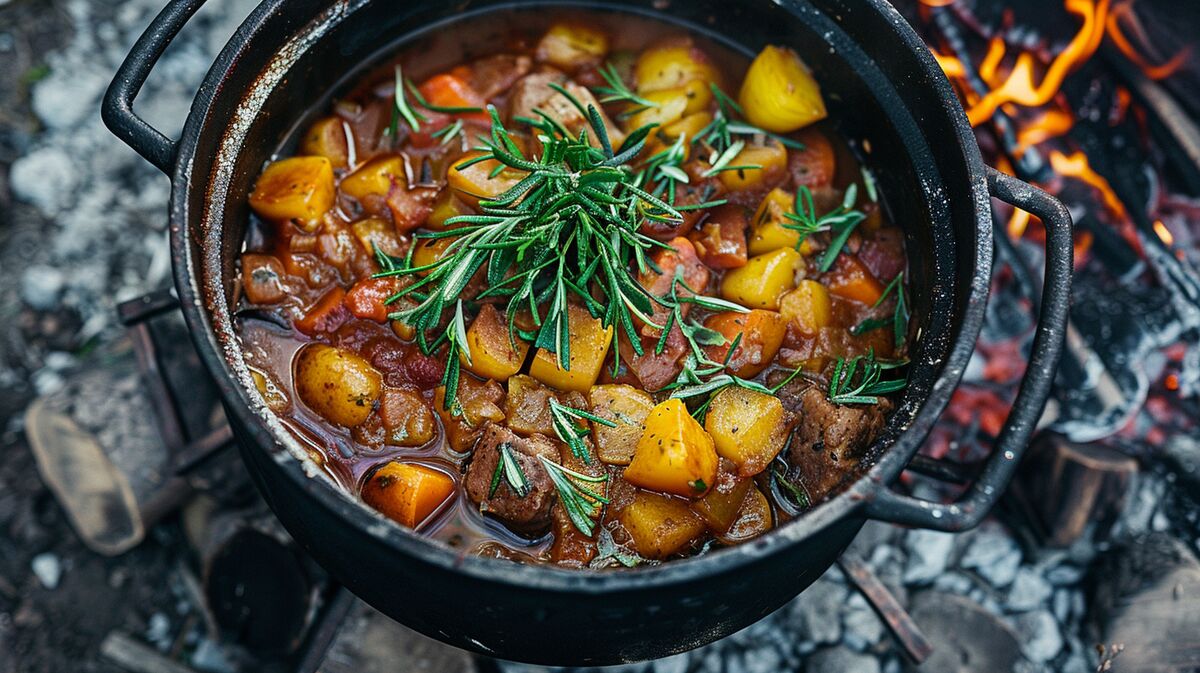
My 9 best outdoor stew recipes - unleash the primal power of nature in your pot.
👉 The key facts from this guide
- Discover 9 simple yet powerful outdoor stew recipes that will keep you full and happy on your hikes
- Learn different cooking methods for the wilderness, from traditional campfires to Dutch ovens
- Find out how to prepare nutritious meals with just a few ingredients, such as campfire chili or wild herb potato stew
- Get practical outdoor tips for each recipe to perfect your cooking skills in nature
- Find answers to common questions about outdoor cooking, from food storage to environmentally friendly practice
Hungry in the forest? Sure, instant soups are easy. But honestly: They neither fill you up nor make you happy.
Imagine you could cook real power bombs right at the campfire. Dishes that recharge and excite you.
Sounds impossible? Not with my tricks! In 10 years of wilderness cooking, I have developed recipes that will amaze you.
Ready to become a stew master? Then let's get started!
How my passion for outdoor stews began
When I took my first hiking tour through the Thuringian Forest 10 years ago, I was a complete outdoor novice.
My backpack was overloaded with canned food and packet soups. After three days, I was tired of eating bland ready-made meals.
On a rainy evening, drenched and hungry, I met another wanderer. He invited me to his meal and conjured up a steaming stew from a few ingredients.
"In the wilderness, you need strength. And that comes from the pot, my boy!"
His words and the taste of this simple yet delicious dish deeply impressed me.
The Birth of My Stew Philosophy
From that moment on, my journey of "self-cooking" began. I experimented with different ingredients, spices, and techniques.
Every hike I tried new things - sometimes complicated, sometimes very simple like a potato soup with self-picked herbs.
My insights:
- Simplicity is King: Few but good ingredients are often enough for a feast.
- Nature as a Spice Rack: Wild herbs give every dish a special touch.
- The Pot Makes the Difference: A good cast iron pot is worth its weight in gold (of course, it's not practical to carry around).
Over the years, I have developed my recipes further. Friends and fellow hikers became enthusiastic taste testers.
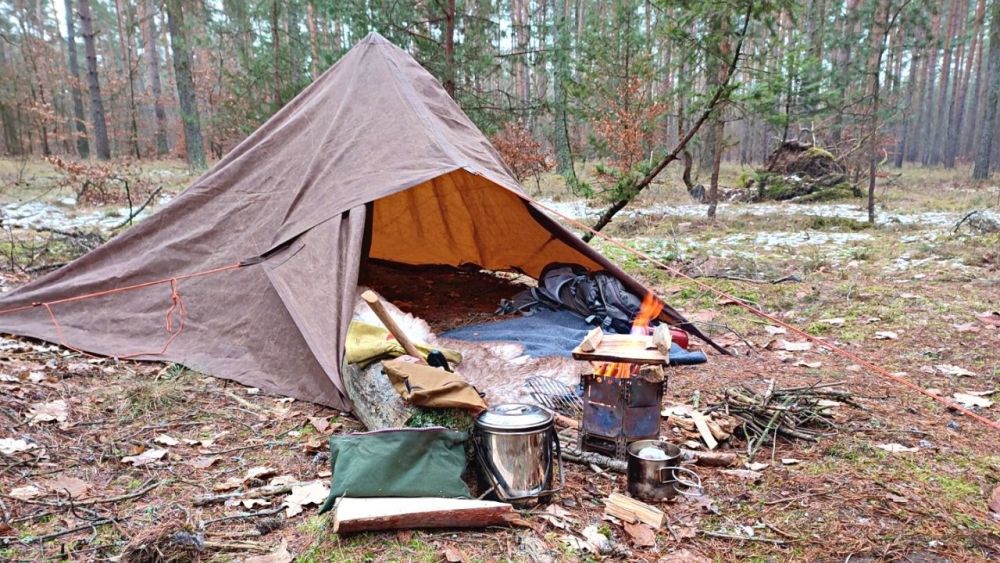
Today, after countless campfires and stews, I can say: There is nothing more satisfying than taking a steaming pot off the fire after a long day of hiking.
In the following recipes, I share with you the essence of my experiences. Each dish is a piece of wilderness, captured in the pot.
Campfire Chili: My Energy Boost for Cold Nights
After a long day of hiking, there's nothing better than a steaming chili. This recipe has gotten me through many a frosty night.
Quick Overview
- Servings: 2
- Preparation time: 35 minutes
- Difficulty: easy
- Equipment: gas stove or hobo, pot
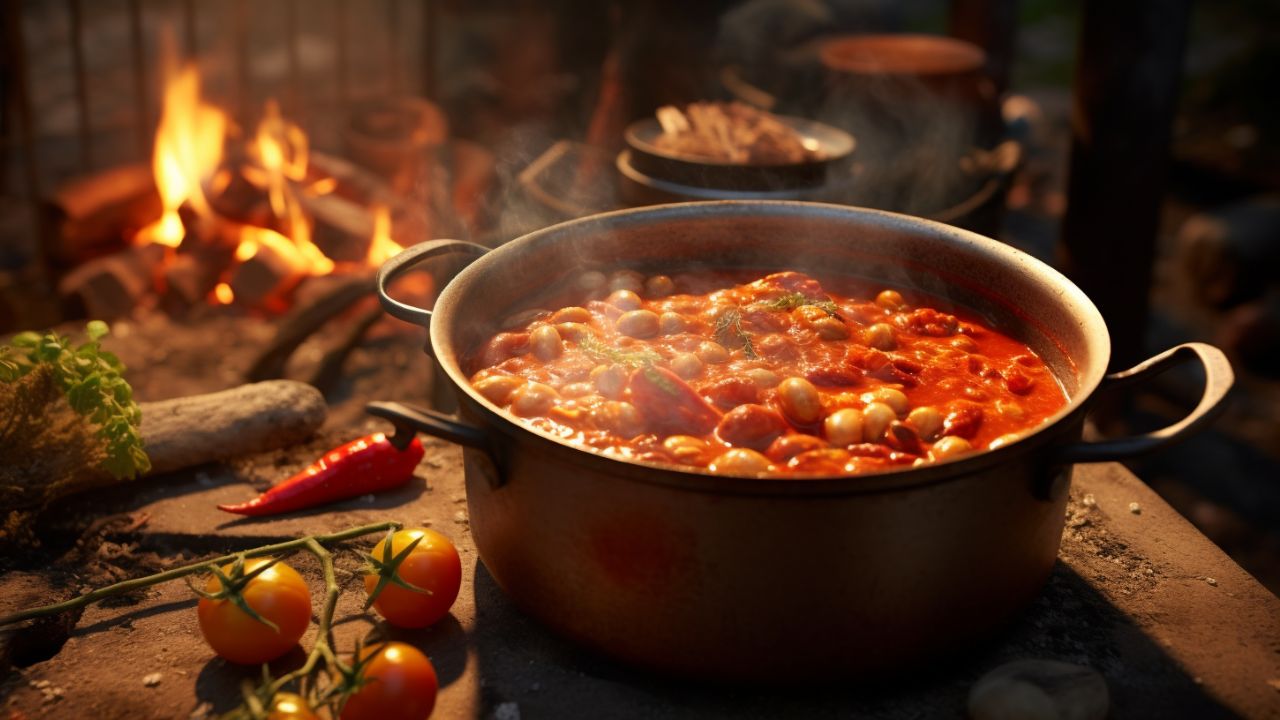
Ingredients
- 1 can of kidney beans (400 g)
- 1 can of chopped tomatoes (400 g)
- 1 large onion
- 2 cloves of garlic
- 1 tbsp chili powder
- Salt and pepper
- 100 g dried minced meat
Preparation
- Set up and heat the gas stove or hobo stove.
- Sauté the onion and garlic.
- Add dried ground meat and briefly fry.
- Season with chili powder, salt, and pepper.
- Add beans and tomatoes.
- Let everything simmer together for 20 minutes.
Outdoor Tips
- Fresh vegetables? Extend cooking time accordingly.
- For extra flavor: Add a pinch of cumin.
- Vegan? Omit ground meat and use more beans.
- Serve with tortilla chips for extra crunch.
My Conclusion
This chili is my go-to for cold evenings. It warms from the inside and gives new energy. I like it best with a piece of crispy bread for dipping.
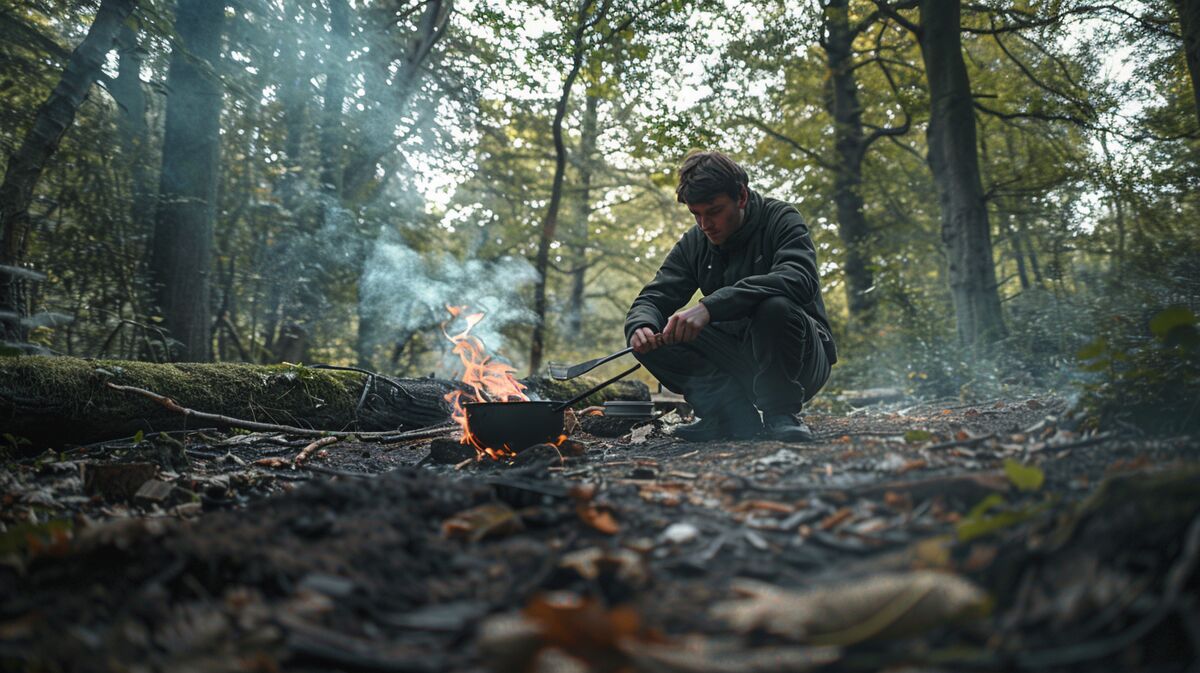
Outdoor Lentil Stew: My Energy Booster for Long Hiking Days
This lentil stew is my secret tip for powerful meals on the go. Easy to prepare and rich in nutrients - just what you need after a long day.
Quick Overview
- Servings: 2
- Preparation time: 40 minutes
- Difficulty: easy
- Equipment: cooker, pot
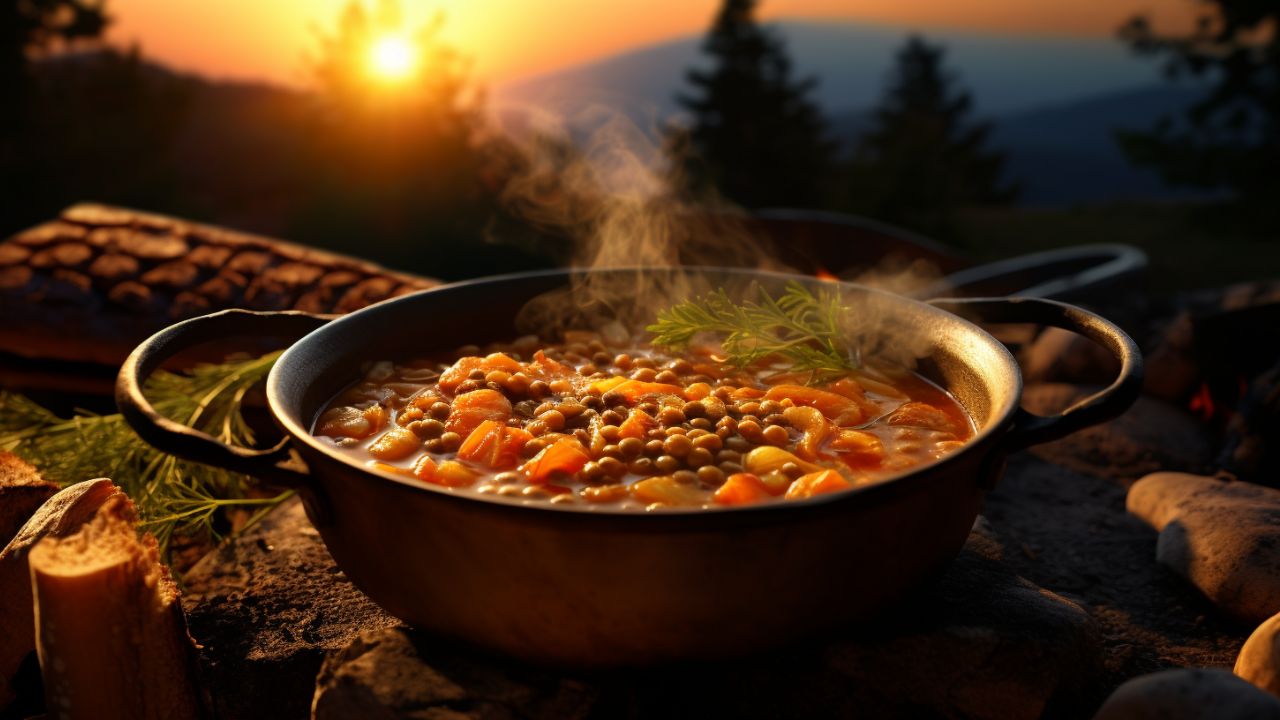
Ingredients
- 150 g dry lentils
- 1 medium-sized onion
- 2 cloves of garlic
- 2 carrots
- 500 ml chicken broth (or bouillon cubes and water)
- Salt and pepper to taste
Preparation
- Chop onion and garlic and sauté.
- Add diced carrots and lentils.
- Pour in chicken broth.
- Simmer for 30 minutes until the lentils are soft.
- Season with salt and pepper.
Outdoor Tips
- Regular stirring prevents burning.
- Cooking time may vary depending on the types of lentils. Check after 20 minutes.
- For meat lovers: Add some bacon or ham.
- Vegetarian version: Replace chicken broth with vegetable broth.
My Conclusion
This lentil stew is my faithful companion on long tours. It fills you up, warms you, and gives you new strength. I like it best with a dash of olive oil and fresh bread.

Wilderness Potato Skillet with Bacon and Garlic: My Favorite Campfire Dish
This stew is my absolute favorite after a long day of hiking. The smell of fried bacon and garlic can even revive tired hikers.
Quick Overview
- Servings: 4
- Preparation time: 1 hour, 15 minutes
- Difficulty: easy
- Equipment: pan, stove or campfire
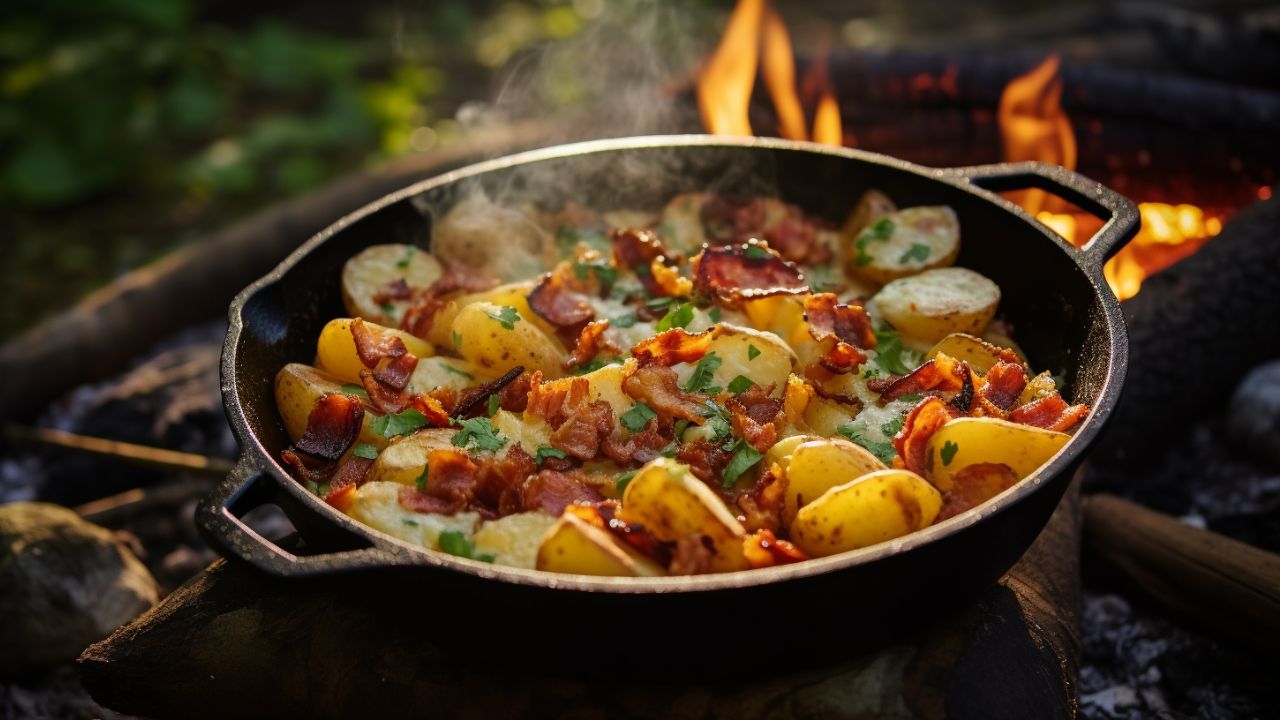
Ingredients
- 500 g potatoes
- 200 g bacon
- 2 onions
- 3 cloves of garlic
- 2 tbsp olive oil
- 1 tsp salt
- 1 tsp pepper
- 1 tsp paprika powder
- 1 tsp rosemary
Preparation
- Wash potatoes and cut into bite-sized pieces.
- Finely chop onions and garlic, dice bacon.
- Heat olive oil, fry bacon until crispy.
- Add potatoes, onions, and garlic and mix.
- Season with spices and stir well.
- Cover and cook over medium heat for 30 minutes, stirring occasionally.
- Taste and adjust seasoning if necessary.
Outdoor Tips
- Waxy potatoes hold their shape better.
- Do not fry the bacon too much - it releases valuable fat for the potatoes.
- Vary the spices: thyme or marjoram also go well.
- Cooking time may vary depending on the size of the potatoes. Always test them!
My Conclusion
This stew is the epitome of outdoor enjoyment for me. The aroma when it sizzles over the campfire is unbeatable. It tastes best to me straight from the pan, surrounded by good friends and stories from the day.
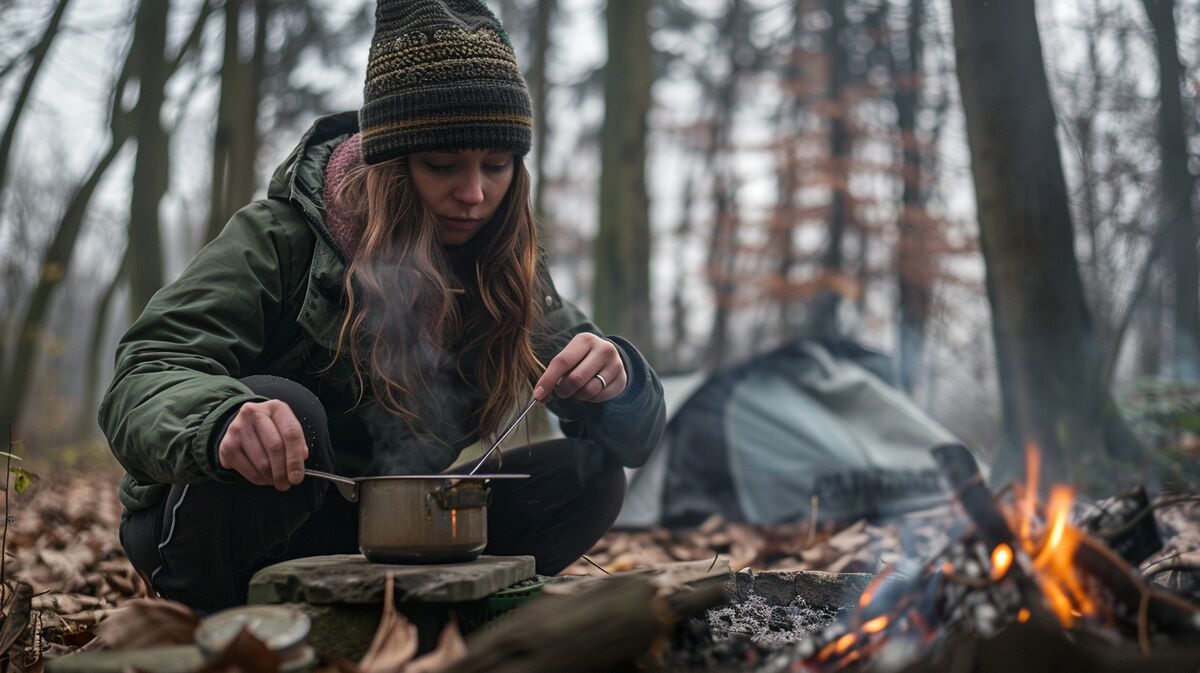
Wilderness Bean Curry with Chickpea Kick: My Exotic Energy Boost
This curry stew is my secret weapon against hunger and cold in the wilderness. It warms you from the inside and provides you with plenty of energy for your adventures.
Quick Overview
- Servings: 4
- Preparation time: 45 minutes
- Difficulty: medium
- Equipment: pot, stove or campfire
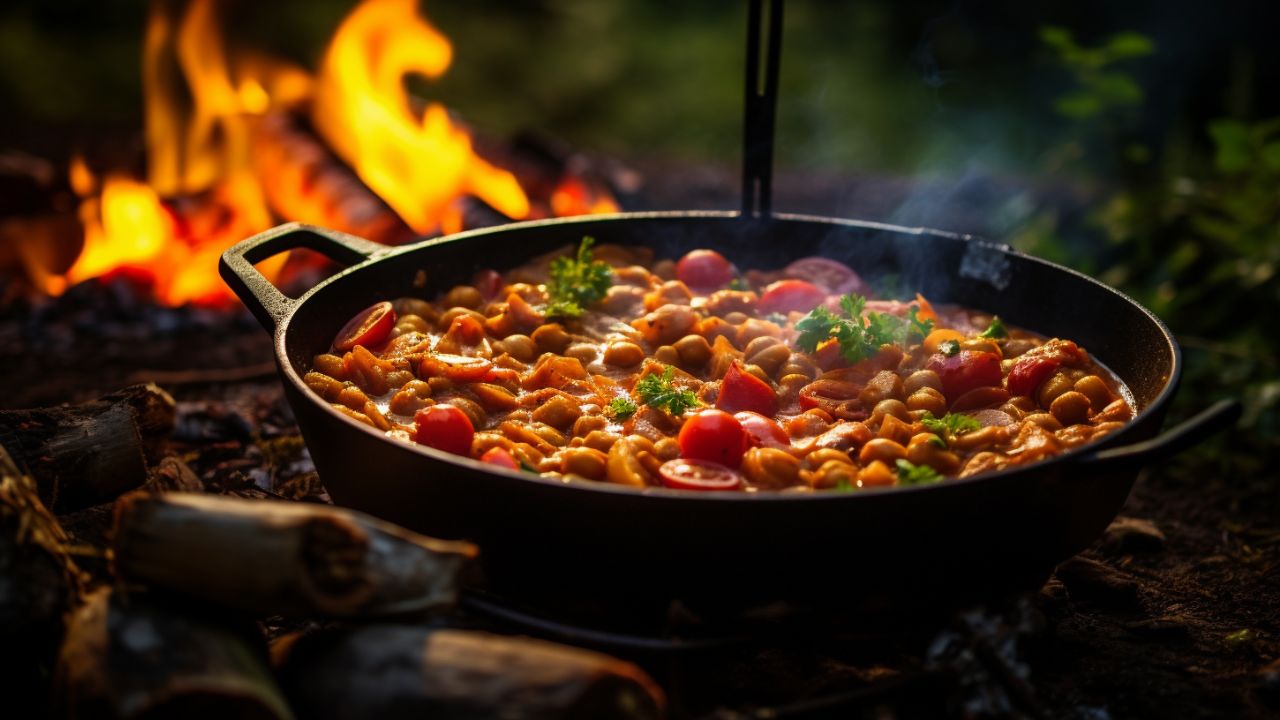
Ingredients
- 400 g beans
- 200 g chickpeas
- 4 tomatoes
- 2 onions
- 3 garlic cloves
- 2 tbsp curry paste
Preparation
- Rinse and drain beans and chickpeas.
- Chop tomatoes, onions, and garlic.
- Sauté curry paste in a pot.
- Add chopped vegetables and briefly sauté.
- Add beans and chickpeas and mix well.
- Deglaze with water and simmer for 30 minutes.
- Season to taste and serve.
Outdoor Tips
- Choose the curry paste according to your taste - there are mild and spicy variants.
- Canned beans and chickpeas save time. For dried legumes, plan for soaking time!
- The curry is an energy booster - perfect after strenuous tours.
- Preparation possible at home: Simply reheat on site.
My Conclusion
This curry stew is my insider tip for cold evenings by the campfire. The scent of the spices mixes with the smoke of the fire, creating a very special atmosphere. It is nutritious, warming, and brings a touch of exoticism to the wilderness. My tip: Enjoy it with a piece of flatbread for dipping!
Wilderness Sausage Spaghetti from the Stew: My Italian Luxury in the Forest
This dish is my tip for everyone who doesn't want to miss out on pasta even in the forest. It combines the comfort of home with the adventure of nature.
Quick Overview
- Servings: 4
- Preparation time: 1 hour, 15 minutes
- Difficulty: medium
- Equipment: Large pan or Dutch oven, campfire or stove
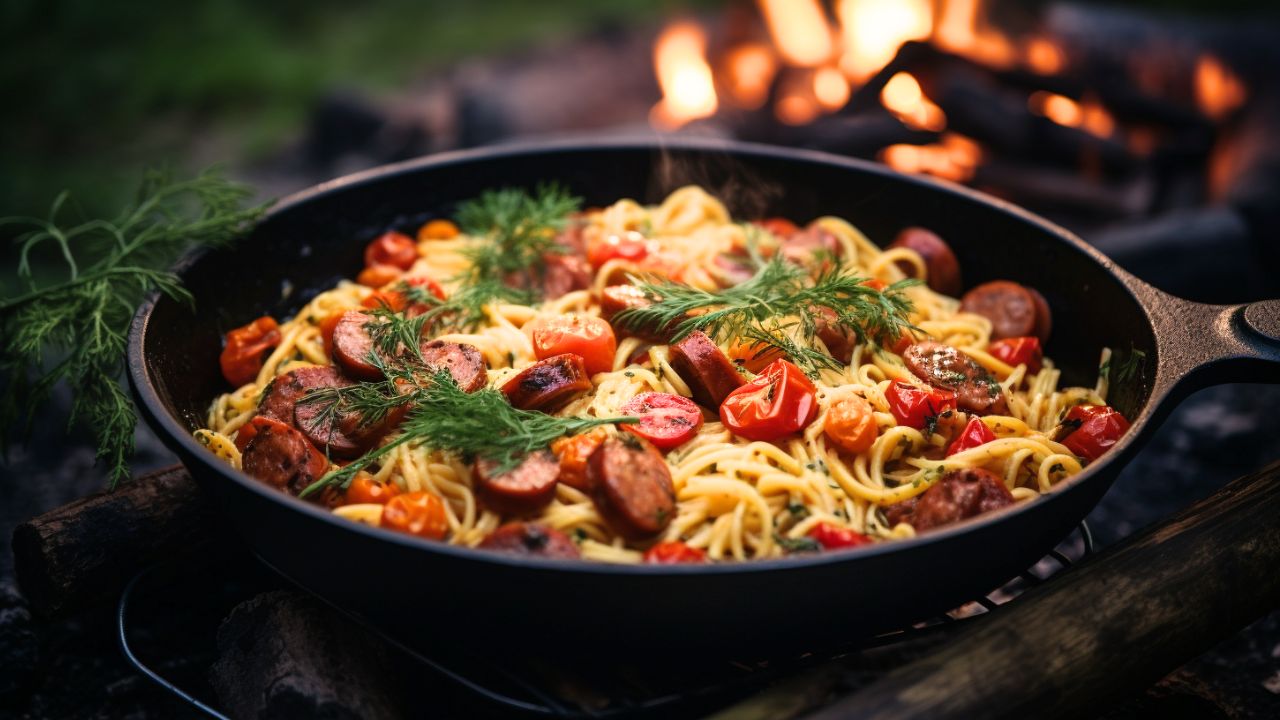
Ingredients
- 1 tbsp olive oil
- 1 large onion, chopped
- 2 cloves garlic, finely chopped
- 200 g coarsely ground spicy Italian sausage
- 680 g spaghetti sauce
- 6 cups water
- Salt and pepper to taste
- 450 g dried thin spaghetti noodles
- 1⁄2 cup fresh basil, chopped
- 1⁄2 cup fresh Parmesan, grated
Preparation
- Heat olive oil in the pan.
- Sauté onion and garlic until soft.
- Add sausage and brown.
- Add spaghetti sauce, water, salt, and pepper and bring to a boil.
- Break pasta in half and stir into the sauce.
- Simmer on low heat for about 10 minutes.
- Serve with basil and Parmesan.
Outdoor Tips
- Save water: Use part of the spaghetti sauce as cooking liquid.
- Sausage alternatives: Dried salami lasts longer and provides intense flavor.
- Herbs: Dried basil is a suitable alternative and easier to transport.
- Cheese: Hard cheese like Parmesan keeps well without refrigeration.
My Conclusion
This dish is my absolute luxury in the wilderness. The scent of garlic and basil mixing with the campfire smoke is unbeatable. It reminds me of cozy evenings in Italy, just in the middle of nature.
My camping luxury tip: Enjoy it with a glass of red wine under the starry sky!
Spicy Wild Herb Potato Stew: My Taste of Nature in a Pot
This stew is my favorite way to capture the flavors of the wilderness. It combines the simplicity of the potato with the variety of wild herbs into a true taste experience.
Quick Overview
- Servings: 2
- Preparation time: 45 minutes
- Difficulty: easy
- Equipment: pot and spoon
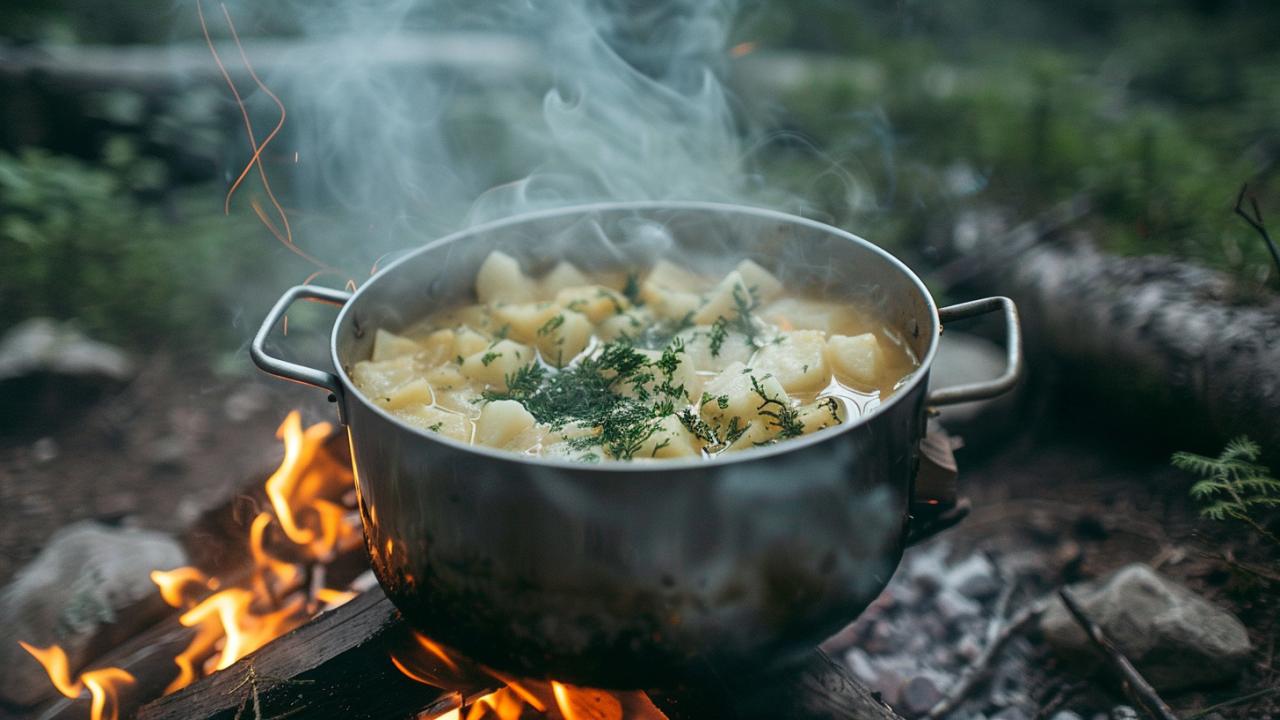
Ingredients
- 4 potatoes
- 1 onion
- 2 cloves of garlic
- 1 liter vegetable broth
- 200 g mixed wild herbs
- 2 tbsp olive oil
- Salt and pepper
- 100ml cream
Preparation
- Peel and dice the potatoes.
- Finely chop the onion and garlic and sauté in olive oil.
- Add the potato cubes and sauté for 5 minutes.
- Deglaze with vegetable broth and simmer for 20 minutes.
- Add wild herbs and cook for another 5 minutes.
- Purée the stew, stir in the cream, and season to taste.
- Garnish with fresh wild herbs and serve hot.
Outdoor Tips
- Wild herb alternatives: Nettle, ground elder, or dandelion are well-suited.
- Dice potatoes evenly for uniform cooking time.
- Vegan? Replace the cream with coconut milk for an exotic touch.
- Wash herbs thoroughly to remove sand and small insects.
My Conclusion
This stew is like a warm embrace from nature. The earthy taste of the potatoes harmonizes perfectly with the fresh notes of wild herbs. It warms not only the body but also the soul. My tip: Enjoy it on a cool evening by the campfire and let yourself be enchanted by the aromas of the wilderness.
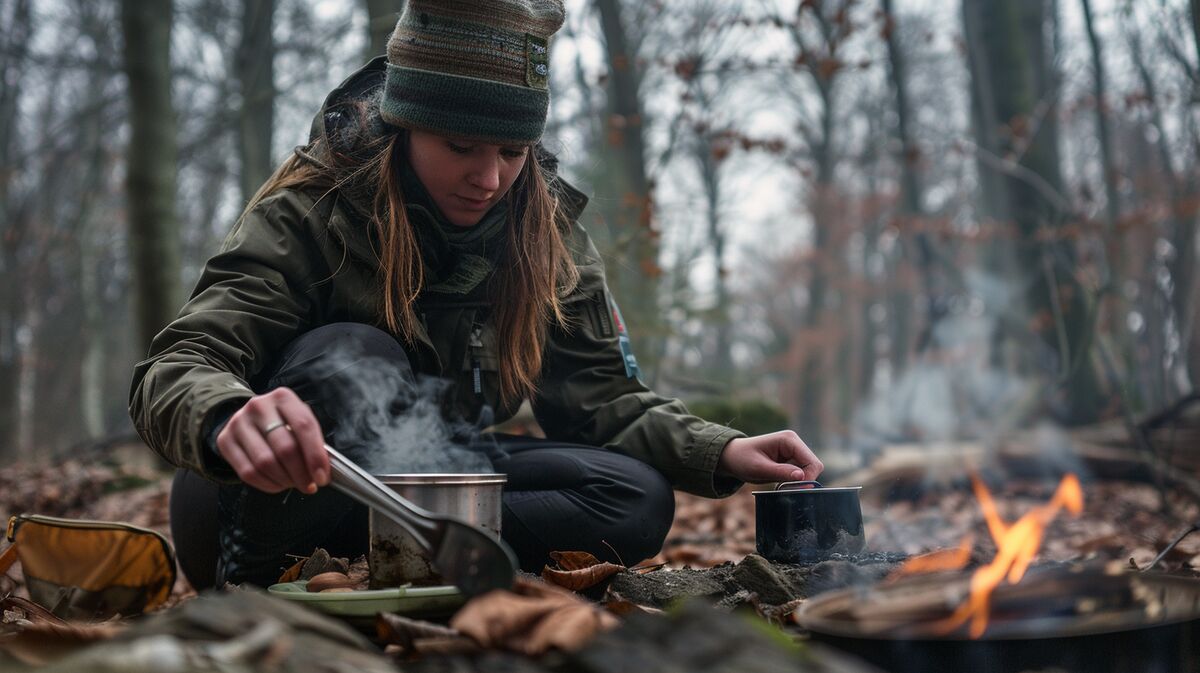
Wild Bean Stew with Bacon: My Feast by the Campfire
This stew is my absolute favorite for cold nights in the forest. It combines the hearty fullness of beans with the smoky aroma of bacon - a true culinary delight under the open sky.
Quick Overview
- Servings: 2
- Preparation time: 45 minutes
- Difficulty: medium
- Equipment: Large pot or Dutch Oven, campfire
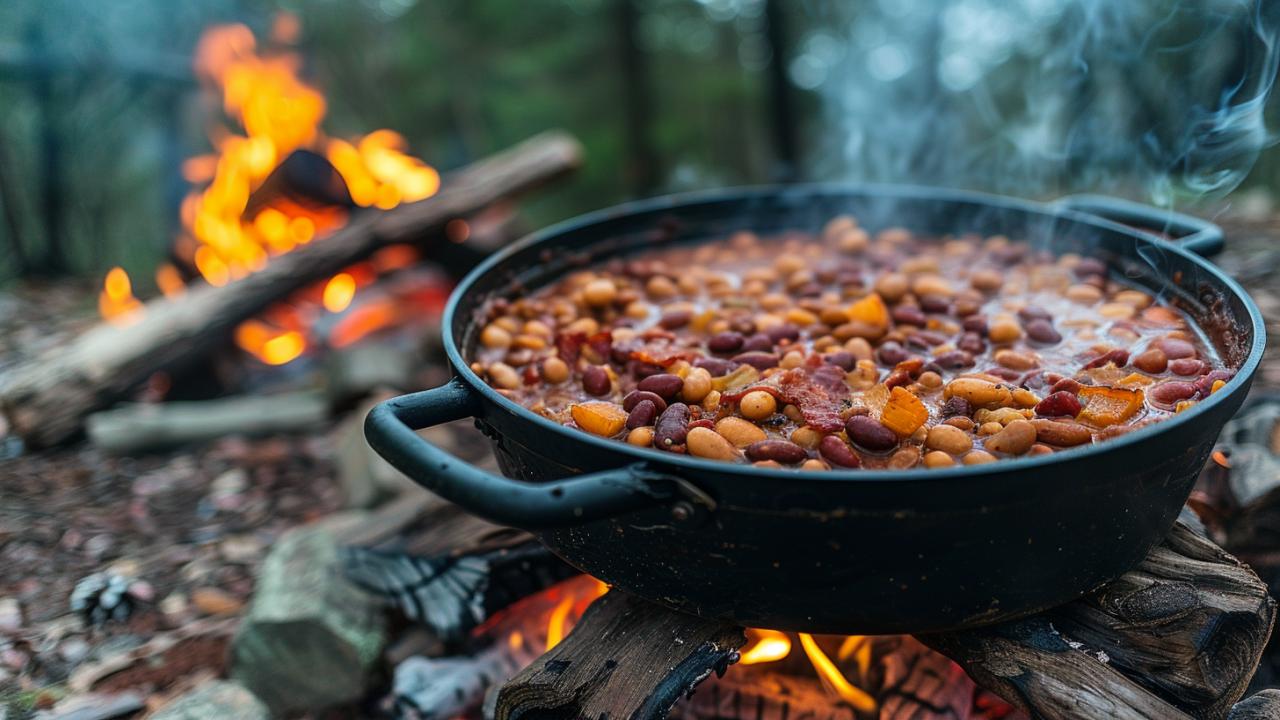
Ingredients
- 400 g canned beans
- 150 g bacon
- 1 onion
- 2 carrots
- 2 garlic cloves
- 1 liter water
- 2 bay leaves
- Salt and pepper
- 1 handful of fresh herbs (e.g., thyme, rosemary)
Preparation
- Dice the bacon and fry it until crispy in a large pot.
- Chop the onions, carrots, and garlic and sauté them.
- Add the beans and stir.
- Pour in water, add bay leaves, salt, and pepper.
- Let it simmer for 30 minutes.
- Remove the bay leaves and season to taste.
- Stir in fresh herbs and serve hot.
Outdoor Tips
- No Dutch oven? A sturdy pot on stones will do as well.
- Dried herbs are a practical alternative - use sparingly!
- A smoked paprika adds extra smoky flavor.
- Regular stirring prevents burning.
My Conclusion
The scent of fried bacon and fresh herbs mingling with the campfire smoke is indescribable. It's not just a meal, but an experience. My tip: Enjoy it with a crispy piece of bread.
Pea Stew with Ham from the Campfire Pot: My Soul Warmer in the Wilderness
This stew is my absolute favorite for long evenings by the campfire. It combines tradition, coziness, and the incomparable taste of outdoor life in one pot.
Quick Overview
- Servings: 4
- Preparation time: 2 hours, 30 minutes
- Difficulty: medium
- Equipment: Large kettle, campfire
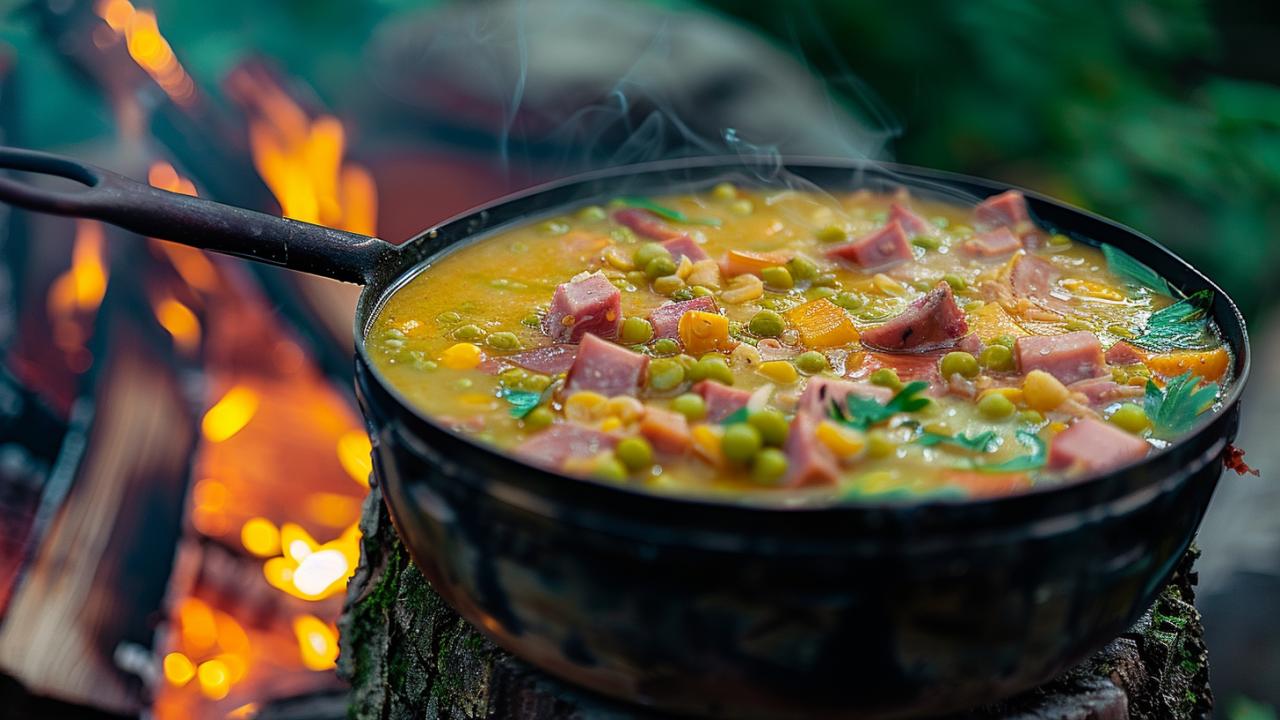
Ingredients
- 500 g dried green peas
- 200 g smoked ham
- 1 onion
- 2 carrots
- 2 cloves of garlic
- 1 leek
- 2 tbsp oil
- 1.5 L water
- 2 bay leaves
- 1 tsp thyme
- Salt and pepper
Preparation
- Soak peas overnight.
- Heat oil in the kettle over the fire.
- Sauté onion and garlic.
- Dice ham and sauté with it.
- Add carrots and leek.
- Add water, peas, bay leaf, and thyme.
- Simmer for 2 hours, stirring occasionally.
- Season with salt and pepper.
Outdoor Tips
- Soaking peas beforehand saves time and energy.
- Even fire prevents burning.
- Tripod or sturdy branch to hang the kettle.
- Let the stew rest after cooking for a more intense flavor.
My Conclusion
This pea stew is really delicious. The aroma that mixes with the smoke of the campfire creates an incomparable atmosphere. It warms not only the body but also the soul.
My tip: Enjoy it with a piece of rustic bread and good friends under the starry sky. That's how real outdoor life tastes!
Bushcraft Bean Pan: My Quick Energy Boost in the Forest
This bean skillet is my ace up my sleeve for quick, hearty meals in the wilderness. It combines simplicity with hearty flavor - perfect for hungry adventurers.
Quick Overview
- Servings: 1
- Preparation time: 20 minutes
- Difficulty: easy
- Equipment: pan, stove or campfire
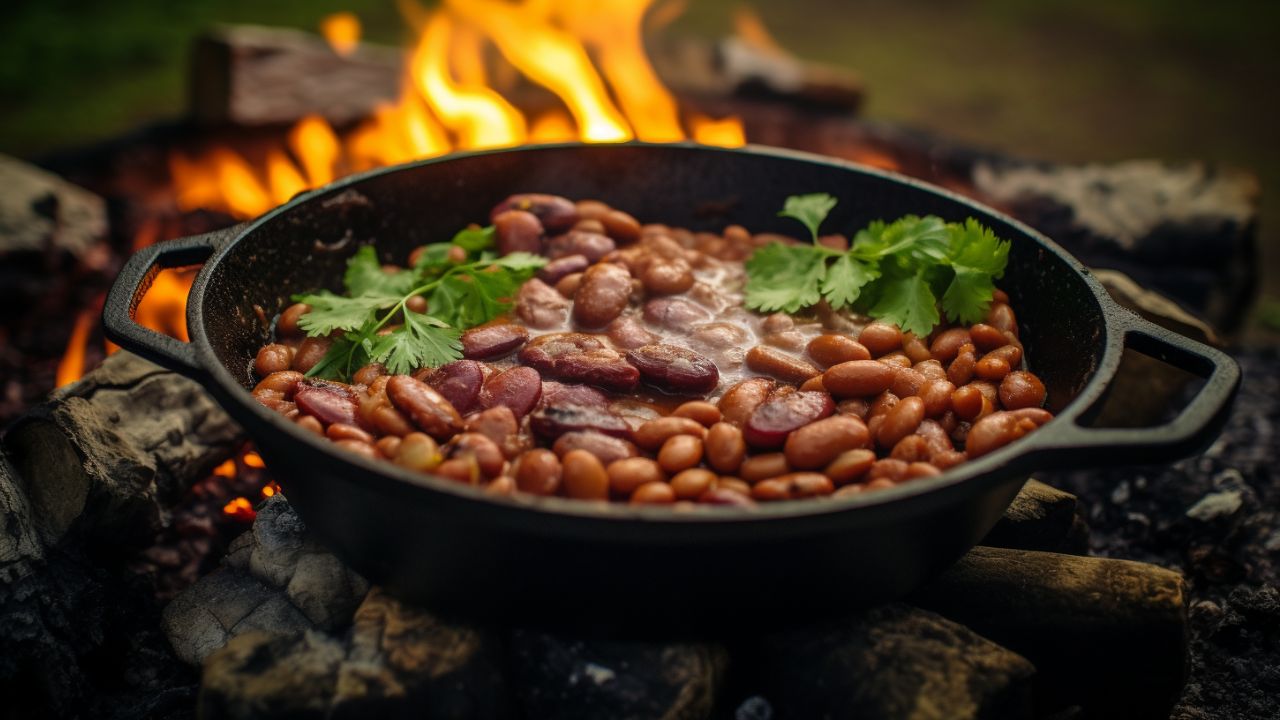
Ingredients
- 1 tbsp oil
- 1 large onion
- 1 bell pepper
- 1⁄2 Hungarian salami
- 1 can of beans in tomato sauce
Preparation
- Dice onions, bell peppers, and salami coarsely.
- Heat oil in the pan, sauté onions.
- Add bell peppers after 1–2 minutes.
- Add salami and briefly roast.
- Add beans with sauce and let it simmer.
Outdoor Tips
- Salami alternatives: kabanossi, Vienna sausages, or cured chicken.
- For spiciness: add chili or paprika powder.
- Pre-cut vegetables save time and space in the backpack.
Here is my video about a similar pan:
My Conclusion
This bean pan is my faithful companion on every tour. It is quick to prepare, wonderfully filling, and gives you the necessary energy for further adventures. The smell of fried salami and bell peppers is sure to attract curious fellow campers!
My tip: Enjoy them directly from the pan while watching the sunset. That's the taste of real bushcraft life!
Potato Stew with mildly smoked sausage: My Rustic Powerhouse
This stew is my culinary trump card for quick recovery after strenuous tours. It combines the filling power of potatoes with the hearty note of mildly smoked sausage - a true delight in the wilderness.
Quick Overview
- Servings: 2
- Preparation time: 30 minutes
- Difficulty: easy
- Equipment: pot, stove or campfire
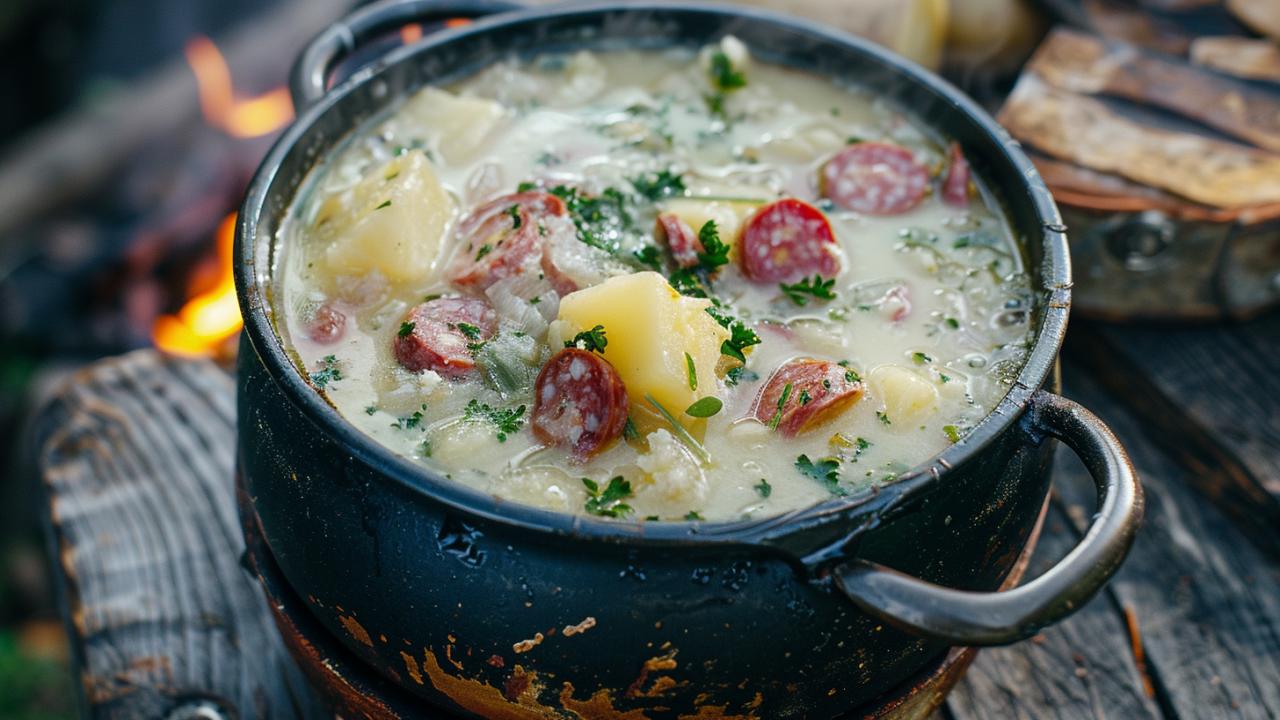
Ingredients
- A handful of potatoes
- 2 smoked sausages
- 1 onion
- Some bouillon cubes
- Salt and pepper
- Herbs (e.g., marjoram)
Preparation
- Peel potatoes, dice them, and put them in boiling water.
- Cut onions and add them to the potatoes.
- Crush bouillon cubes and add them.
- Cook until the potatoes are soft.
- Cut Mettenden into slices and add them.
- Season with salt, pepper, and herbs.
Outdoor Tips
- Take pre-cut potatoes in a waterproof box, saves time.
- Dried herbs are lighter and last longer. Fresh herbs are even better.
- For extra energy: Add carrots, leeks, or celery.
- Vegetarian option: Replace sausage with smoked tofu.
Conclusion
This potato stew is my personal classic on every outdoor tour. It warms from the inside, satisfies, and gives new strength for further adventures.
The scent of potatoes and sausages mingling with the smoke of the campfire is, for me, the epitome of bushcraft romance.
Cooking Methods for Your Outdoor Stews
There are different ways to prepare these delicious stews in nature:
-
Campfire: The traditional method. Use a tripod or sturdy stones to place your pot over the fire.
-
Camping stove: Practical and quick. Ideal for areas with fire restrictions.
-
Dutch Oven: Perfect for slow-cooked stews. It distributes heat evenly and retains flavors well.
-
Hobo stove: A DIY option made from tin cans or purchased (What is a Hobo stove?). Eco-friendly and efficient.
-
Cooking pit: An ancient method. Dig a hole, place hot stones inside, and position your pot on top.
Choose the method that best suits your equipment and local conditions. Experiment and find out what you enjoy the most!
Read also
Outdoor stoves – Which type of camping stove suits you? – Which bushcraft stove suits you? The one with gas, petrol, alcohol, or Esbit? Or the one with wood? Get an overview of all bushcraft stoves.
Frequently Asked Questions about Outdoor Cooking
1. How do I store food safely while camping?
- Use a well-insulated cooler, a cool box, or a root cellar (when you are at your camp)
- Keep raw meat separate from other foods.
- Avoid opening the cooler unnecessarily to preserve the cold.
- Use ice packs or frozen water bottles for cooling.
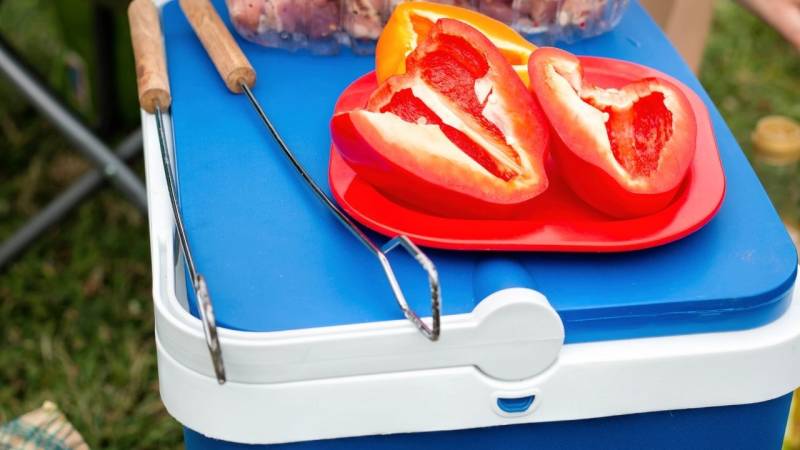
2. Which cooking utensils are indispensable for an outdoor kitchen?
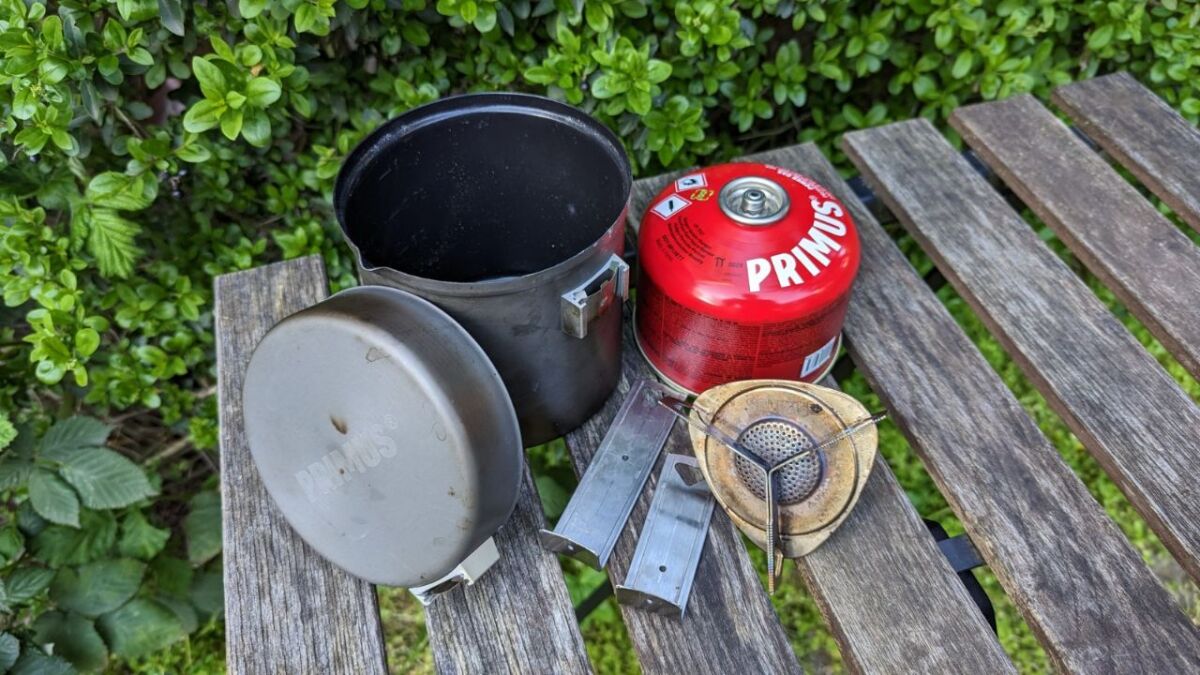
3. How do I safely light a campfire?
- Choose an official fire pit or create a safe area.
- Collect dry fuel / tinder of various sizes.
- Start with small kindling and work your way up to larger pieces of wood.
- Always have water ready to extinguish the fire if necessary.
- Observe local regulations and fire warnings.
4. How do I clean my cookware in the wilderness?
- Remove food scraps and bury them far away from the camp.
- Use biodegradable dish soap and hot water (if available).
- Use sand or gravel as a natural scouring agent for uncoated pans. For coated pans, I use moss to wipe the pan.
- Rinse thoroughly with clear water.
- Let the dishes air dry.
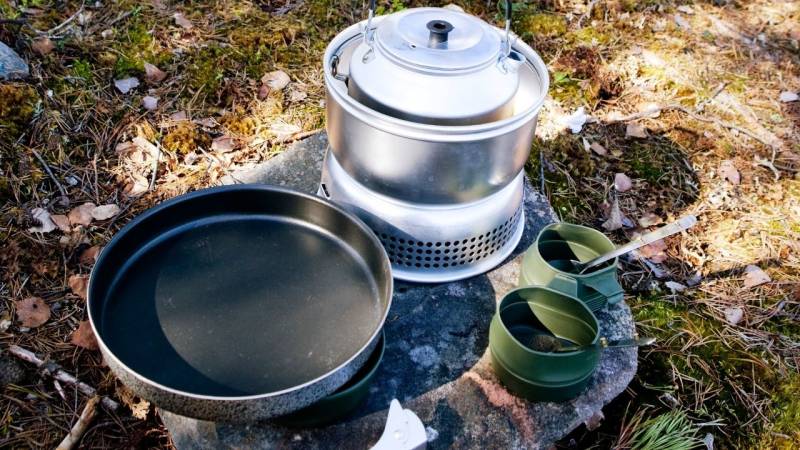
5. How do I plan the right quantities for outdoor meals?
- Calculate about 1.5 to 2 times as much per person as for regular meals.
- Consider the planned activities and the weather.
- Plan simple, nutritious meals for the first and last day.
- Bring some snacks for extra energy.
6. How do I deal with wildlife when cooking outdoors?
- Store food in airtight, odor-proof containers.
- Do not cook or eat near your sleeping area.
- Dispose of food scraps and waste properly and far away from the camp.
- Be aware of local wildlife (such as wild boars) and educate yourself on proper behavior.
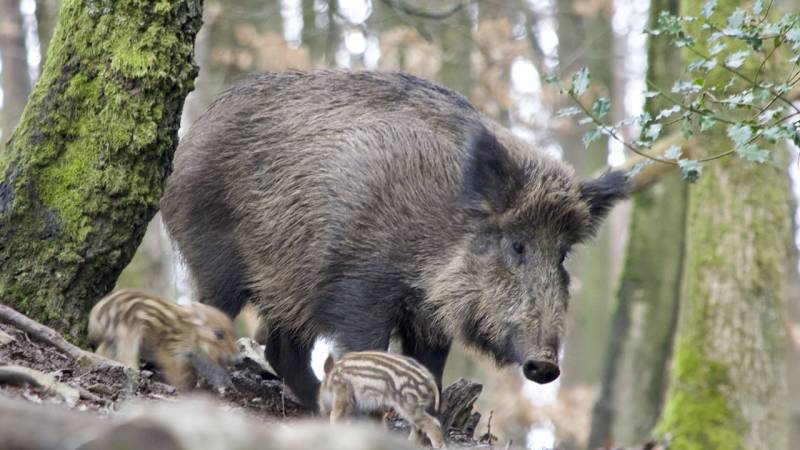
7. Which foods are particularly suitable for outdoor cooking?
- Dried foods such as pasta, rice, beans
- Canned goods (vegetables, beans, tuna)
- Hard cheese and durable sausages
- Nuts and dried fruits
- Instant coffee or tea bags
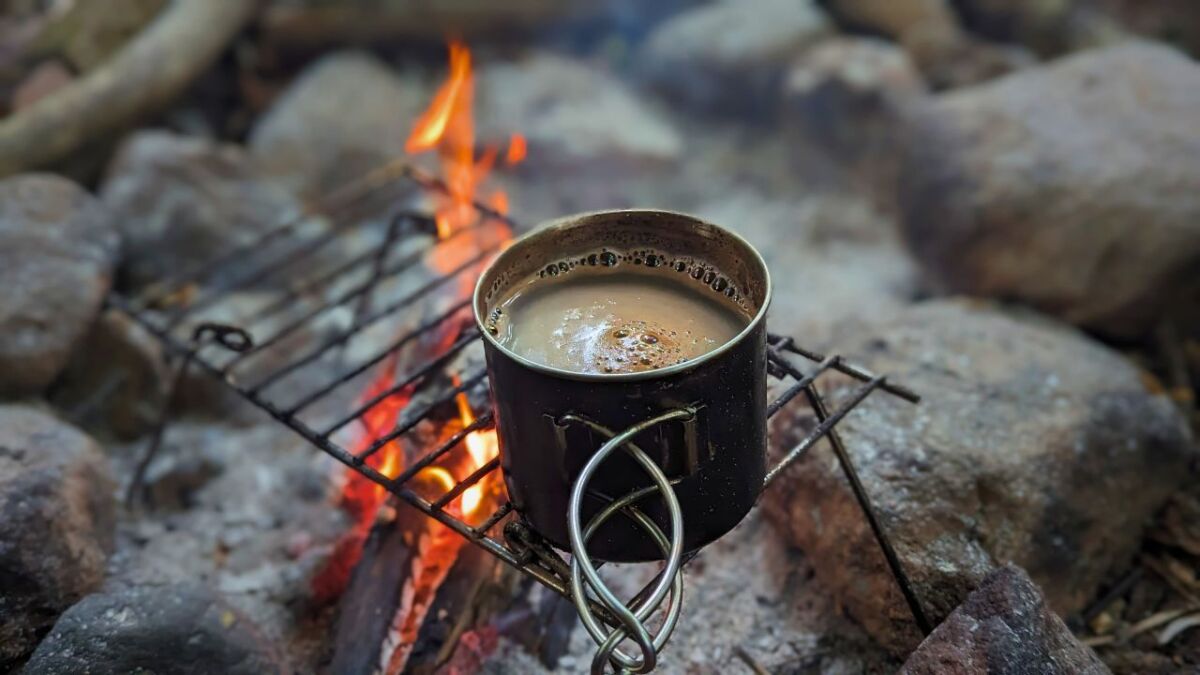
8. How can I make my outdoor cooking experience more environmentally friendly?
- Use reusable dishes and cutlery.
- Avoid disposable packaging and products.
- Take all the trash with you and dispose of it properly.
- Use biodegradable products (e.g., dish soap).
- Respect nature and leave no lasting impact.
Read also
The 7 Leave No Trace Principles and Their Application: Your Guide to Environmentally Conscious Outdoor Behavior – Discover how the Leave No Trace principle can revolutionize your nature experience. Protect what you love and find out all the details about this environmental protection code here.
Your adventure begins in the outdoor kitchen
Wow, what a culinary journey through the wilderness! I hope these 9 stew recipes have made you as hungry as they made me. Whether it's a hearty bean pan, spicy pea stew, or savory potato stew - there's something here for every outdoor fan.
Now it's your turn: Grab your backpack, pack the stove, and try these dishes yourself!

I am super excited to find out which recipe will be your favorite. Please let me know in the comments - which one do you want to try first? What sounds the most delicious to you?
And when you are back from your adventure, tell me about your experiences. Did everything work out? Did you perhaps even improve the recipe? I look forward to your story and tips!
So, what are you waiting for? Get out into nature and enjoy your meal!


Author of the guide
Martin Gebhardt
Hey, I'm Martin. On my blog, you will learn the basics and numerous details about living in the wild. I think survival, bushcraft and the good life in nature are the keys to happiness. Find me here on Instagram or on YouTube. You can find more about my mission on the About Me page.
Was this guide helpful?
17 people found this guide helpful.
5.00 out of 5 points (17 Ratings)
Comments (0)
This post may contain affiliate links. So if you click on the links and make a purchase, I will receive a small commission at no additional cost to you. Click here, to learn more about it.


